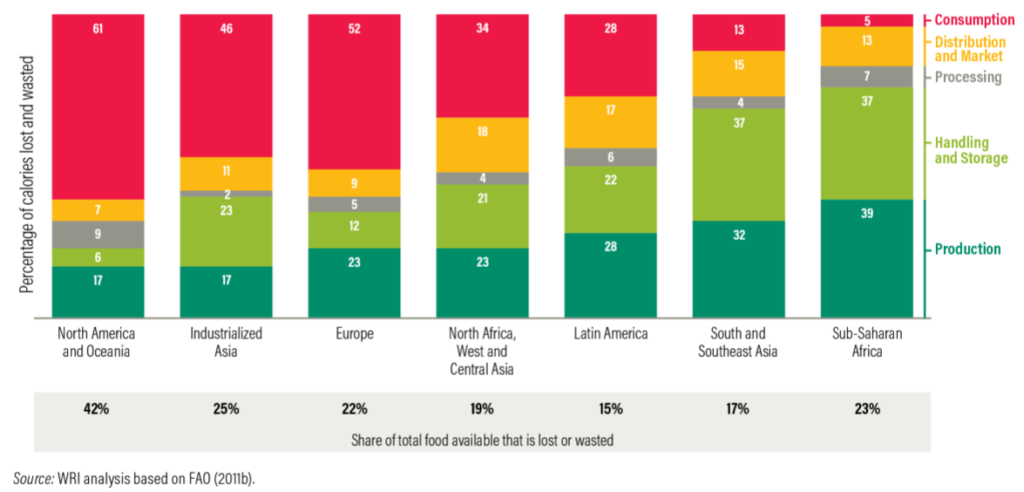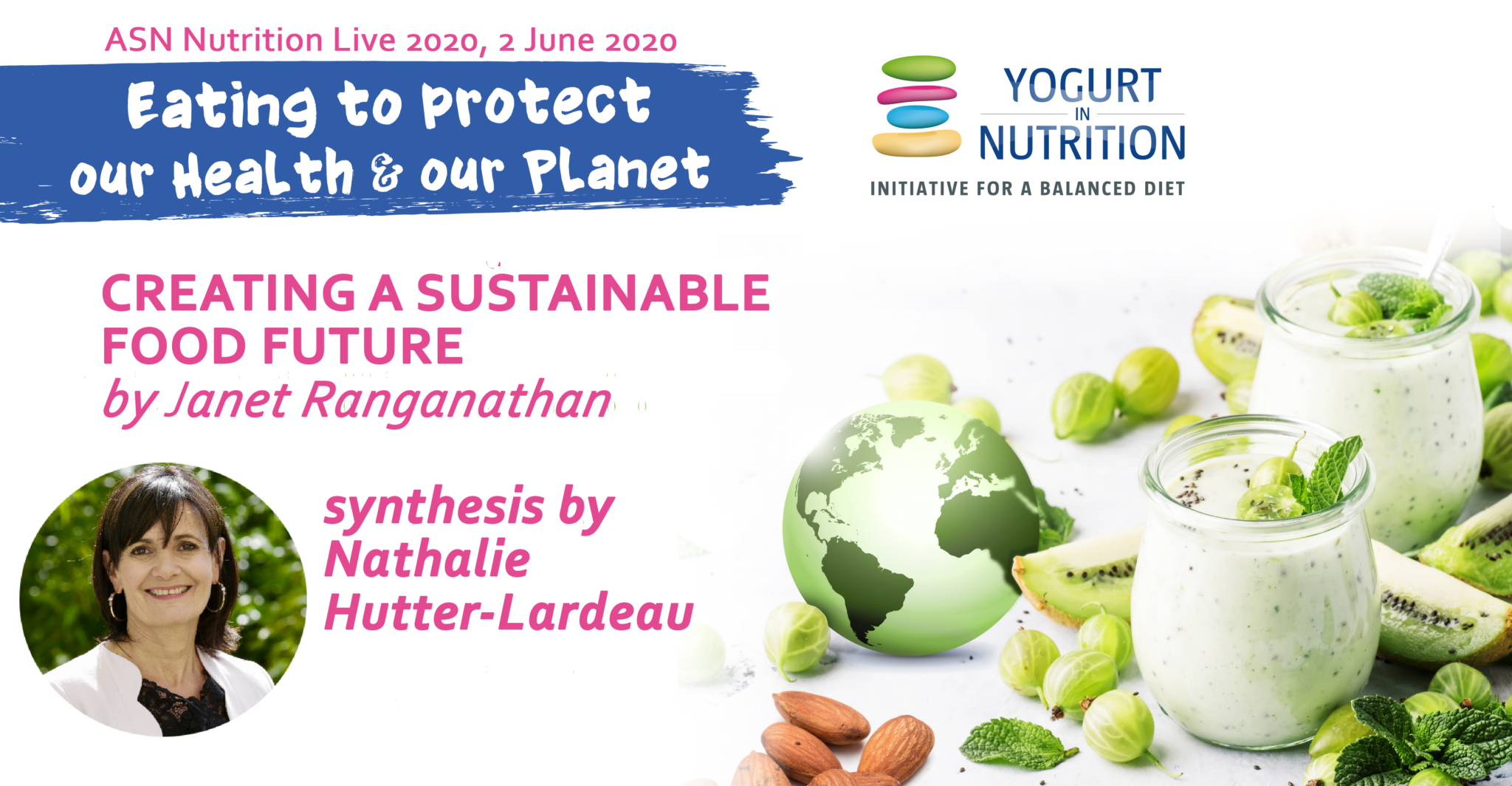For our online symposium « Eating to protect our health and our planet », we asked Nathalie Hutter-Lardeau to cover Janet Ranganathan’s talk for us. Nathalie Hutter-Lardeau is nutritionist, author and multiple business manager. Follow her on Twitter: @NathalieHUTTER
Nutrition 2020 Live Online, which took place between 1st and 4th June 2020, offered virtual attendees from all over the world a great content of lectures and scientific sessions. One of the sponsored satellite programs organized on June 2nd by the Yogurt in Nutrition Initiative for a Balanced Diet examined the question of “Eating to protect our Health and Our Planet”. The session started with a very complete and pragmatic speech entitled:
“Creating a sustainable food future: a menu of solutions to feed nearly 10 billion people by 2050”.
It was delivered by Janet Ranganathan, Vice President for Research, Data, and Innovation at the World Resources Institute (WRI), a global research organization.
Janet Ranganathan has been involved in sustainable development for more than 25 years. What she learnt from her experience in this field is that the roots of many environmental issues can be led back to the food sector.
She started her talk by explaining that a couple of years ago with the WRI she started to look at the food sector trying to find out possible solutions to make it more sustainable, rather than focusing on problems.
To feed 10 billion people sustainably by 2050, it will be necessary to fill the three following gaps:
- The food gap which is the difference between the amount of calories produced in 2010 and the amount necessary to meet to feed the population adequately by 2050. This gap is estimated to be 7,400 trillion calories, or 56 percent more crop calories than were produced in 2010.
- The land gap which corresponds to the difference between global agricultural land area used in 2010 and the area required in 2050. This gap which is estimated to be 593 million hectares (an area nearly twice the size of India) should be brought to zero by 2050.
- The GHG mitigation gap which represents the difference between the annual greenhouse gas (GHG) emissions from agriculture and land-use change in 2050 estimated at 15 gigatons of carbon dioxide equivalent (Gt CO2e). It also represents the target of 4 Gt that represents agriculture’s proportional contribution to holding global warming below the level necessary for preventing the worst climate impacts. This means a gap of 11 Gt to be filled knowing that agricultural emissions in 2050 baseline equal 70% of total allowable emissions for all sectors in 2050.
Janet Ranganathan also underlined that about 28% of the global population is connected directly or indirectly to employment in the agricultural sector.
There is no silver bullet to close these gaps but that there are combined approaches that together can help fill these gaps. J. Ranganathan, WRI, June 2020
WRI has identified 22 solutions to increase productivity and to decrease consumption. The relative importance of each solution varies from country to country.
These solutions are organized into a five-course menu.
1/ Reduce the growth in demand for food and other agricultural products
One approach to solve this, would be to reduce food loss and waste. 32% of global food (when expressed in weight according to FAO data) corresponding to 24% when calculated in calories by the WRI is wasted around the world. Waste happens at every step of the supply chain. In poorer countries, waste occurs closer to the field and in richer countries nearer to the fork. Thus, waste generated at production level represents respectively 36% in sub-Saharan Africa and 17% in North America and Oceania whereas the part of waste occurring at consumption level is 5% in sub-Saharan Africa and 61% in North America and Oceania (graph.1).

The WRI looked at strategies to reduce food loss and waste at each step of the chain, i.e. improve harvesting and storage techniques, reduce food loss and waste, change date labeling practices or reduce portion sizes.
If cities, countries and businesses could measure food loss and waste, they would certainly do more to manage it. Janet Ranganathan also mentioned the CHAMPIONS 12.3 INITIATIVE involving private and public sector leaders who committed themselves to cut per capital food waste in half by 2030.
In order to reduce growth in demand, we will also have to shift to healthier and more sustainable diets. Globally, diets are converging towards more Western style diets, people are consuming more calories and proteins than required and there is an overall overconsumption of proteins. Likewise demand for animal-based protein is projected to grow 80% by 2050. All foods are not equal regarding their environmental impact. Animal based foods are more resource-intensive than plant-based foods. If we take the example of meat, reducing the consumption of ruminant meat to 52kcal per day in all regions reduces GHG gap by half and nearly closes the land gap. WRI-led innovation hubs including food companies involved in the food sector have worked on innovative strategies that can help to shift eating habits. One interesting approach highlighted by Janet Ranganathan is that of menu language which can influence food choices and for instance make fruits and vegetables more appealing. It has been shown that people will opt for indulgently labeled foods such as for example “twisted garlic-ginger butternut squash wedges” rather than for basic “butternut squash”.
Among other proposals to reduce growth in demand for food is the idea to avoid competition from bioenergy for food crops and land. Indeed, if the world’s entire harvest crops were used for bioenergy, it would only provide 20% of energy needs in 2050. Dedicating land to bioenergy production should be avoided if it is to sustainably feed the global population in 2050.
2/ Increase food production without expanding agricultural land
To achieve this goal, the productivity of livestock and pasture must be increased. Science breakthroughs will help the improvement of crop breeding to boost yields and more importantly the adaptation to climate change.
3/ Natural ecosystems must be protected and restored
Indeed, unproductive and liberated agricultural lands must be reforested and cropland expansion should be kept at its minimum and preferably to lands with low environmental opportunity costs. A special attention should be given to peatlands which are drained and thus emitting GHG without speaking of the destruction of their ecosystems. Finally, we need to link productivity gains with the protection of natural ecosystems.
4/ Increase fish supply
In order to meet the world fish demand in 2050, we need to increase fish supply and aquaculture production must continue to grow. To preserve the biodiversity and marine ecosystems, wild fisheries management should be improved as well as the productivity and environmental performance of aquaculture.
5/ Reduce GHG emissions from agricultural production
Many solutions are available through new technologies, manure management or nitrogen use efficiency. Shifting to nonfossil energy sources must be considered and encouraged. We also need to focus on realistic options in order to sequester carbon in soils.
This session was the occasion for J. Ranganathan to provide a realistic overview of lots of solutions implemented in different food sectors to fill 3 major gaps identified by the WRI in order to be able to sustainably feed the planet in 2050. There is no silver bullet but combining these solutions to fill each gap with the help of new technologies will hopefully contribute to prepare a sustainable future as well as generate co-benefits such as economic development.



